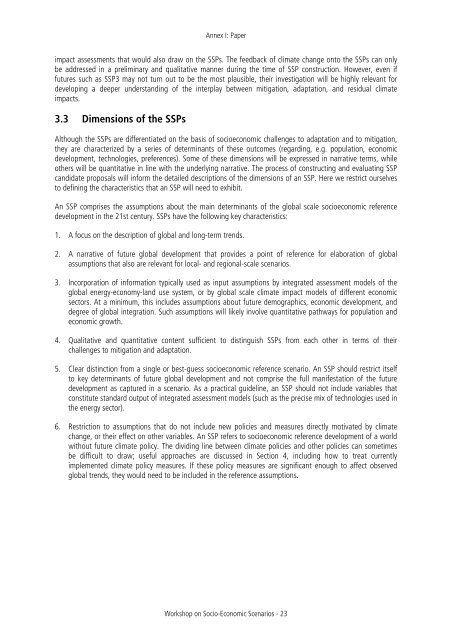Workshop Report - IPCC
Workshop Report - IPCC
Workshop Report - IPCC
Create successful ePaper yourself
Turn your PDF publications into a flip-book with our unique Google optimized e-Paper software.
Annex I: Paper<br />
impact assessments that would also draw on the SSPs. The feedback of climate change onto the SSPs can only<br />
be addressed in a preliminary and qualitative manner during the time of SSP construction. However, even if<br />
futures such as SSP3 may not turn out to be the most plausible, their investigation will be highly relevant for<br />
developing a deeper understanding of the interplay between mitigation, adaptation, and residual climate<br />
impacts.<br />
3.3 Dimensions of the SSPs<br />
Although the SSPs are differentiated on the basis of socioeconomic challenges to adaptation and to mitigation,<br />
they are characterized by a series of determinants of these outcomes (regarding, e.g. population, economic<br />
development, technologies, preferences). Some of these dimensions will be expressed in narrative terms, while<br />
others will be quantitative in line with the underlying narrative. The process of constructing and evaluating SSP<br />
candidate proposals will inform the detailed descriptions of the dimensions of an SSP. Here we restrict ourselves<br />
to defining the characteristics that an SSP will need to exhibit.<br />
An SSP comprises the assumptions about the main determinants of the global scale socioeconomic reference<br />
development in the 21st century. SSPs have the following key characteristics:<br />
1. A focus on the description of global and long-term trends.<br />
2. A narrative of future global development that provides a point of reference for elaboration of global<br />
assumptions that also are relevant for local- and regional-scale scenarios.<br />
3. Incorporation of information typically used as input assumptions by integrated assessment models of the<br />
global energy-economy-land use system, or by global scale climate impact models of different economic<br />
sectors. At a minimum, this includes assumptions about future demographics, economic development, and<br />
degree of global integration. Such assumptions will likely involve quantitative pathways for population and<br />
economic growth.<br />
4. Qualitative and quantitative content sufficient to distinguish SSPs from each other in terms of their<br />
challenges to mitigation and adaptation.<br />
5. Clear distinction from a single or best-guess socioeconomic reference scenario. An SSP should restrict itself<br />
to key determinants of future global development and not comprise the full manifestation of the future<br />
development as captured in a scenario. As a practical guideline, an SSP should not include variables that<br />
constitute standard output of integrated assessment models (such as the precise mix of technologies used in<br />
the energy sector).<br />
6. Restriction to assumptions that do not include new policies and measures directly motivated by climate<br />
change, or their effect on other variables. An SSP refers to socioeconomic reference development of a world<br />
without future climate policy. The dividing line between climate policies and other policies can sometimes<br />
be difficult to draw; useful approaches are discussed in Section 4, including how to treat currently<br />
implemented climate policy measures. If these policy measures are significant enough to affect observed<br />
global trends, they would need to be included in the reference assumptions.<br />
<strong>Workshop</strong> on Socio-Economic Scenarios - 23

















